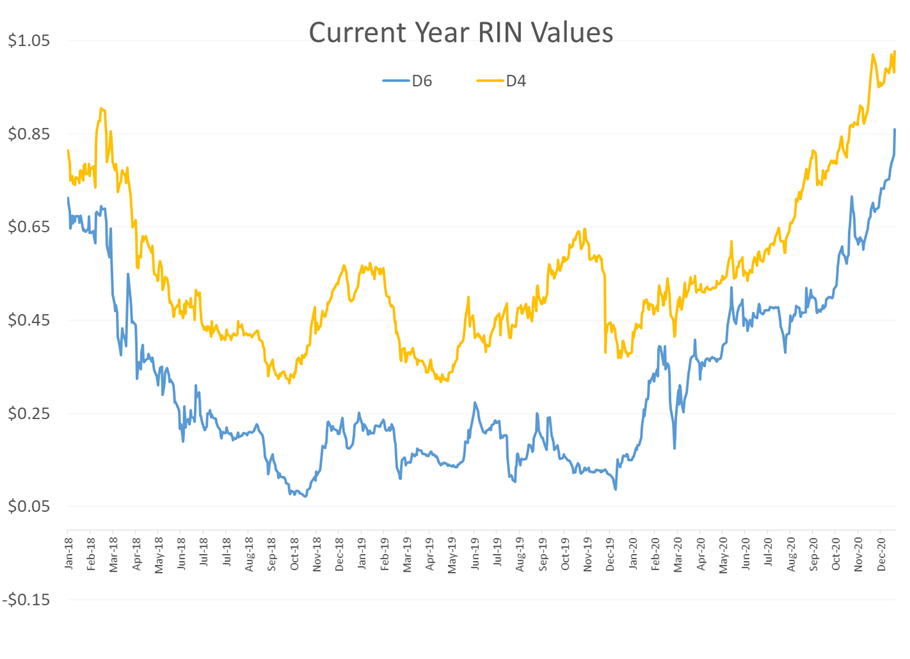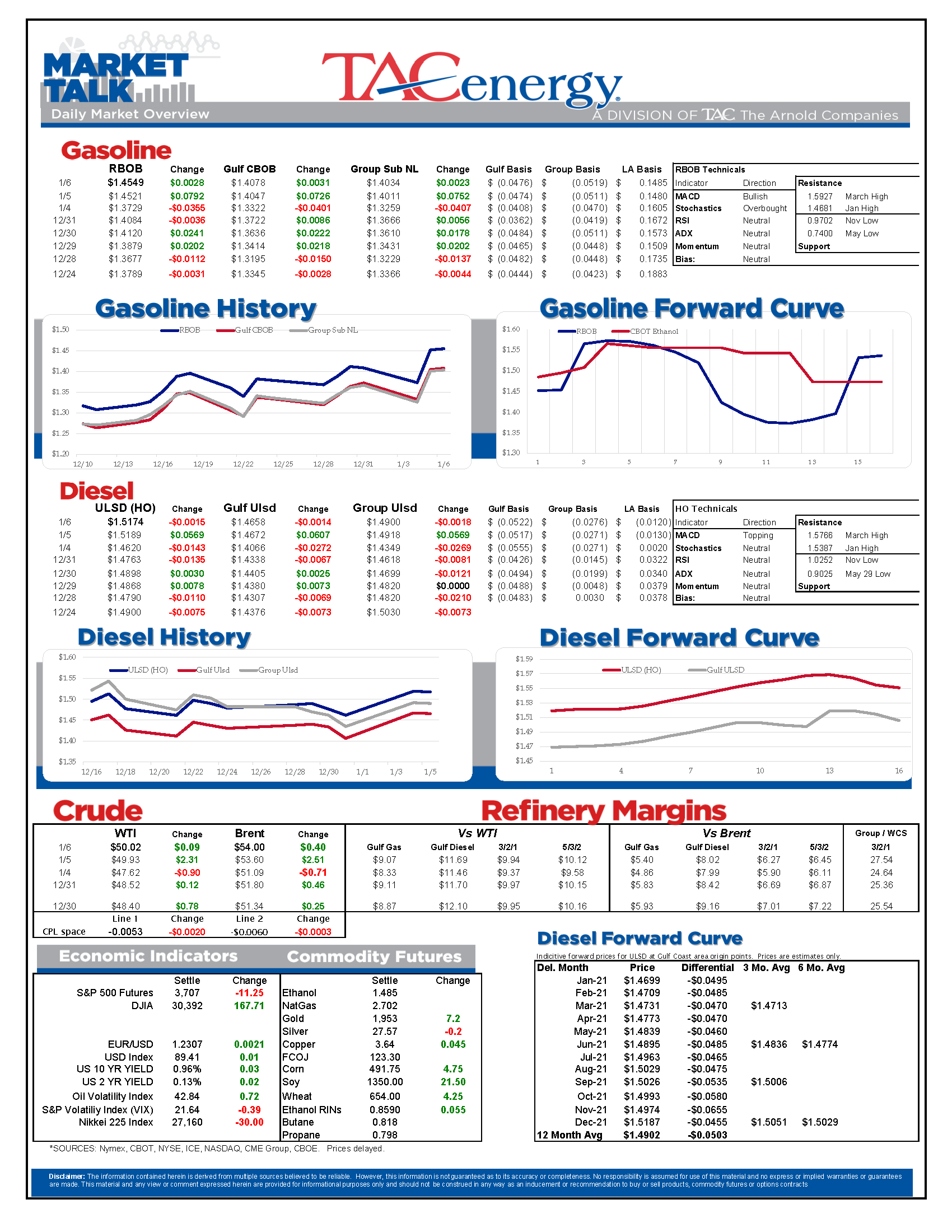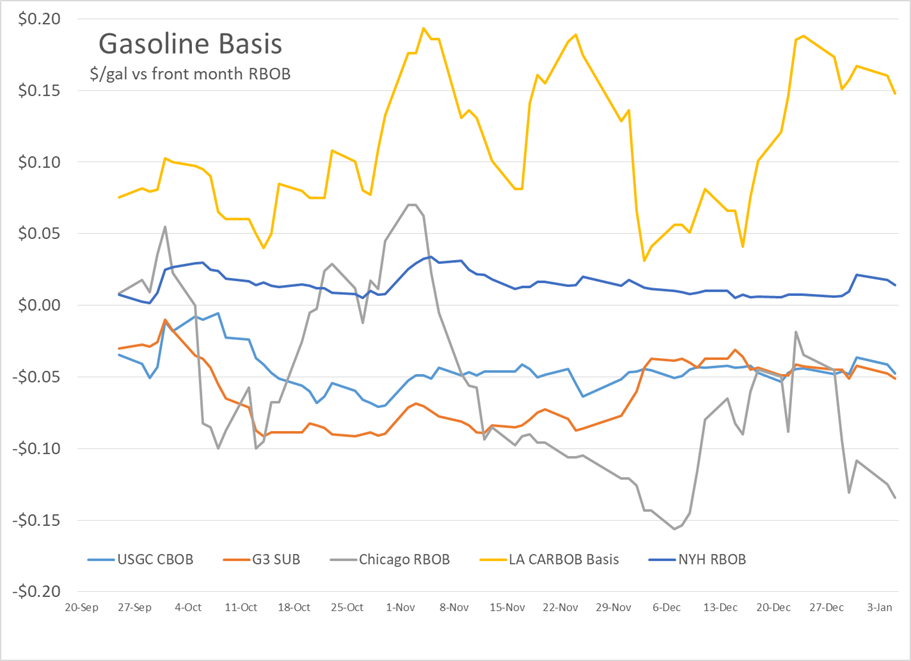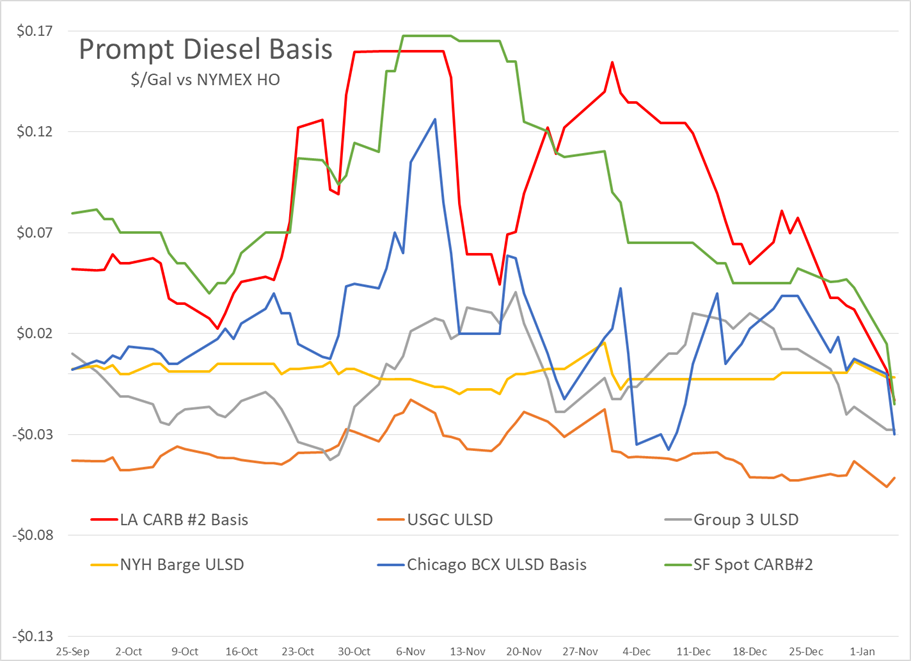Senate Election Results Impact On Financial Markets

We’ve had a busy couple of weeks’ worth of price action so far in 2021, and we’re just starting our third day of trading. Energy prices have gone from the cusp of a technical breakout to the upside, to a huge reversal that threatened a price collapse, and back again to 10 month highs in just two days. Prices are starting Wednesday’s session with more of a wait-and-see approach after being unable to sustain their rally overnight. OPEC-inspired whiplash is getting most of the credit for the big swings in energy markets, while the Senate election results look like they’ll be the big story today that will likely have broader impacts on financial markets.
Saudi Arabia surprised pretty much everyone Tuesday by announcing it would unilaterally cut its oil output by one million barrels/day, which would allow Russia and other countries to increase their output, without flooding the global market as demand continues to sputter. While the move shocked the markets, which responded with a furious rally in oil and refined product futures, it seems to be in some ways the Kingdom making good on the promise it made in the fall to do whatever is necessary to stabilize the global oil markets and teach speculators a lesson. This move also sets the stage for some interesting political theatre once demand returns, as the Saudi’s will no doubt remember those that supported them in this effort, and probably even more those that did not.
Not buying it? As the basis charts below show, differentials for physical prices in most regional U.S. spot markets dropped on the day as cash markets seem to think the current supply/demand realities are not as optimistic as the futures market action suggests. That hesitation by the big physical traders could be enough to stall the momentum in futures, just as they look like they’re breaking technical resistance and poised for another rally. The API report in the afternoon gave more reason for fundamentalists to have doubts about the recent run-up as both gasoline and diesel saw large very large inventory builds last week (5.5 and 7.1 million barrels respectively) but that report seems to have been largely lost in the shuffle of the bigger news stories. The DOE’s report will be out at its normal time today, but you’ll be forgiven if you miss it while watching the election coverage.
Early results appear to show that Democrats will win both seats in Georgia, flipping control of the Senate, and giving the party control of Congress and the White House for at least two years. There will surely be some selling as control of the legislative and executive branches will no longer be split, assuming the current calls hold, but some other reports suggest we could see some risk assets rally as this change could also make new fiscal stimulus measures easier to sign into law.
For energy markets in particular, a flip in the Senate will almost certainly mean more aggressive laws to combat climate change, which in some cases may mean tighter restrictions on traditional oil producers and refiners. That is not necessarily bearish for prices however as more restrictions tend to mean less supply (and less investment) which could end up driving an extended rally in prices if demand recovers this year.
The reaction in RIN markets today may give us an early indication of how traders in the refined product space view the changing of the guard in the Senate. RIN prices have already been surging lately, in sympathy with corn and soybean prices that are reaching multi-year highs largely due to concerns over South American grain exports, and this latest bit of news could encourage another strong rally if the market believes the new congress will push for increased renewable mandates. Then again, the RIN market is notoriously volatile, and there could be some buy the rumor sell the news once the current bout of short covering is over.
Click here to download a PDF of today's TACenergy Market Talk.
Latest Posts
The Struggle For Renewable Producers Continues As A Rapid Influx Of Supply And Crashing Credit Prices Make Biodiesel
After Years Of Backwardation, Diesel Prices Have Slipped Into Contango Over The Past Week
Gasoline Futures Are Leading The Way Lower This Morning
The Sell-Off Continues In Energy Markets, RBOB Gasoline Futures Are Now Down Nearly 13 Cents In The Past Two Days
Social Media
News & Views
View All
The Struggle For Renewable Producers Continues As A Rapid Influx Of Supply And Crashing Credit Prices Make Biodiesel
The sigh of relief selloff continues in energy markets Tuesday morning, with gasoline prices now down more than 20 cents in 7 sessions, while diesel prices have dropped 26 cents in the past 12. Crude oil prices are within a few pennies of reaching a 1 month low as a lack of headlines from the world’s hot spots allows some reflection into the state of the world’s spare capacity for both oil and refined products.
Gasoline prices are trading near a 6-week low this morning, but still need to fall about another nickel in order to break the weekly trendline that pushed prices steadily higher since December. If that trend breaks, it will be safer to say that we saw the end of the spring gasoline rally on April 12th for the 2nd year in a row. Last year RBOB futures peaked on April 12 at $2.8943 and bottomed out on May 4th at $2.2500. The high (at this point) for this year was set on April 12th at $2.8516, and the low overnight was $2.6454.
It’s not just energy commodities that are seeing an unwind of the “flight to safety” trade: Gold prices had their biggest selloff in 2 years Monday and continue to point lower today. Just how much money poured into commodities in the weeks leading up to the direct confrontation between Israel and Iran is unclear, but we have seen in year’s past that these unwind-events can create a snowball effect as traders can be forced to sell to cover their margin calls.
Supply > Demand: The EIA this morning highlighted the record setting demand for natural gas in the US last year, which was not nearly enough to offset the glut of supply that forced prices to a record low in February. A shortage of natural gas in Europe was a key driver of the chaotic markets that smashed just about every record in 2022, and an excess of natural gas supply in Europe and the US this year is acting as a buffer, particularly on diesel prices.
The struggle for renewable producers continues as a rapid influx of supply and crashing credit prices make Biodiesel, RD and SAF unprofitable for many. In addition to the plant closures announced in the past 6 months, Vertex Energy reported Monday it’s operating its Renewable Diesel facility in Mobile AL at just 50% of capacity in Q1. The truly scary part for many is that the $1/gallon Blender's tax credit ends this year and is being replaced by the “Clean” Fuel production credit that forces producers to prove their emissions reductions in order to qualify for an increased subsidy. It’s impossible to say at this point how much the net reduction will be for domestic producers, but importers will get nothing, and at current CI values, many biodiesel producers may see their “blend credit” cut by more than half.
Click here to download a PDF of today's TACenergy Market Talk.

After Years Of Backwardation, Diesel Prices Have Slipped Into Contango Over The Past Week
The pullback continues for energy prices as violence in the Middle East looks like it won’t rapidly expand, and financial markets continue to struggle with a higher-for-longer interest rate reality.
After years of backwardation, diesel prices have slipped into contango over the past week, despite multiple canal disruption concerns of reduced exports coming out of Russia. A Reuters article highlights how sluggish demand in Europe, and a glut of Asian supply [thanks to the rapid influx of new refining capacity over the past 2 years] is contributing to the changing market structure. This sudden weakness in diesel is also leading many refiners to reconsider their max-diesel output stance that had been key to their record setting margins in 2022 and 2023.
Money managers were reducing their bets on higher energy prices last week, in what appears to be an unwind of the positions added the prior week when it seemed like we might have an all-out war between Israel and Iran. The exception to the reduction in speculative length was the Brent crude oil contract which saw its money manager positions increase for a 4th week to reach a 3-year high. Open interest in crude oil contracts is also increasing to multi-year highs as new money flows into the energy space as a hedge of both inflation and geopolitical concerns, which could contribute to a tick higher in volatility if the sell-off continues this week as the bandwagon jumpers may soon be looking for a new ride.
Baker Hughes reported a net increase of 5 oil rigs drilling in the US last week, while natural gas rigs dropped by 2 on the week to a fresh 2 year low. The Permian basin has quietly added 8 more rigs in the past 4 weeks as producers in that region try to find a way around the shipping bottlenecks to get their otherwise profitable production to market. An RBN note last week highlighted how the lack of natural gas pipeline capacity will limit crude oil production capacity in the basin, and Kinder Morgan highlighted the need for another pipe in its latest earnings call.
Valero reported an upset at its Corpus Christi West refinery Saturday, although it appears that the brief flaring didn’t reduce operational levels.
Click here to download a PDF of today's TACenergy Market Talk.

Gasoline Futures Are Leading The Way Lower This Morning
It was a volatile night for markets around the world as Israel reportedly launched a direct strike against Iran. Many global markets, from equities to currencies to commodities saw big swings as traders initially braced for the worst, then reversed course rapidly once Iran indicated that it was not planning to retaliate. Refined products spiked following the initial reports, with ULSD futures up 11 cents and RBOB up 7 at their highest, only to reverse to losses this morning. Equities saw similar moves in reverse overnight as a flight to safety trade soon gave way to a sigh of relief recovery.
Gasoline futures are leading the way lower this morning, adding to the argument that we may have seen the spring peak in prices a week ago, unless some actual disruption pops up in the coming weeks. The longer term up-trend is still intact and sets a near-term target to the downside roughly 9 cents below current values. ULSD meanwhile is just a nickel away from setting new lows for the year, which would open up a technical trap door for prices to slide another 30 cents as we move towards summer.
A Reuters report this morning suggests that the EPA is ready to announce another temporary waiver of smog-prevention rules that will allow E15 sales this summer as political winds continue to prove stronger than any legitimate environmental agenda. RIN prices had stabilized around 45 cents/RIN for D4 and D6 credits this week and are already trading a penny lower following this report.
Delek’s Big Spring refinery reported maintenance on an FCC unit that would require 3 days of work. That facility, along with several others across TX, have had numerous issues ever since the deep freeze events in 2021 and 2024 did widespread damage. Meanwhile, overnight storms across the Midwest caused at least one terminal to be knocked offline in the St. Louis area, but so far no refinery upsets have been reported.
Meanwhile, in Russia: Refiners are apparently installing anti-drone nets to protect their facilities since apparently their sling shots stopped working.
Click here to download a PDF of today's TACenergy Market Talk.



